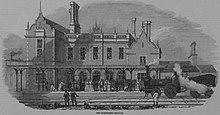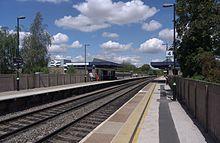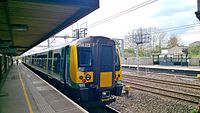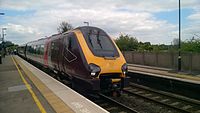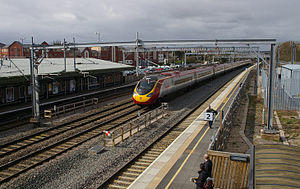 Tamworth Station looking westbound on the West Coast Main Line | |
| Location | Tamworth, Borough of Tamworth England |
| Coordinates | 52°38′15″N 1°41′13″W / 52.6374°N 1.6869°W |
| Grid reference | SK213044 |
| Managed by | London Northwestern Railway |
| Platforms | 4 |
| Other information | |
| Station code | TAM |
| Classification | DfT category C2 |
| Passengers | |
| 2015/16 | |
| 2016/17 | |
| 2017/18 | |
| 2018/19 | |
| Interchange | 0.336 million |
| 2019/20 | |
| Interchange | |
| Notes | |
Passenger statistics from the Office of Rail and Road | |
Tamworth is a split-level railway station which serves the town of Tamworth in Staffordshire, England. It is an interchange between two main lines; the Cross Country Route and the Trent Valley section of the West Coast Main Line (WCML). It has four platforms: Two low-level platforms (1 and 2) on the WCML, and two high level platforms (3 and 4) served by the Cross Country Route. Historically there were chords connecting the two lines, but there is no longer any rail connection between them.
History
The original station was opened on 12 August 1839[1] by the Birmingham and Derby Junction Railway on its original route from Derby to Hampton-in-Arden meeting the London and Birmingham Railway for London.
On 26 June 1847 the London and North Western Railway opened its Trent Valley Line[2] passing beneath the original line with a new joint station designed by John William Livock.[3]
The joint station did not acquire the "High Level" and "Low Level" names until 1924.[4] Since it was expected that only local trains would call, the platforms were on loops, with the running lines left clear for expresses. At that time there was a north to west curve linking the, by then, Midland with the LNWR line. Since it was the crossing of two major lines – one Bristol to Newcastle, the other Euston to Aberdeen – it was important for the Royal Mail transferring upwards of 2,000 bags every night.
A north to east curve was also built very early on by the Trent Valley Railway and the Birmingham & Derby Junction railway, and track was laid on it, but it is not known whether it was ever used. It was certainly lifted by the turn of the century. The track left the Trent Valley line and climbed on an embankment until it crossed the River Anker via a bridge, then entered a cutting until reaching the Midland line. The bridge, known locally as the Spider Bridge, was demolished sometime during the late 1960s by the Royal Engineers, and the cutting was filled in shortly afterwards, so there is little to see nowadays except for the vegetation-covered embankment leading to the bridge.
Prior to the introduction of diesel engines, Tamworth Railway Station was particularly well known to 'train spotting' enthusiasts as the closest station to Birmingham at which the larger and faster steam engines could be seen on the London to the North West Coast Line. The south-east corner, where the lines crossed, was at that time a vacant field, and used to be filled with spotters who would bring refreshments and spend the whole day there. A housing estate now occupies that spot.
There was a large water tower and pumping station at the east end of the low level, pumping water from the River Anker below.
The original station was demolished in 1961 and a new station was designed by the architects for the London Midland Region of British Railways, Maurice Wheeler, E.G. Girdlestone and J.B. Sanders.[5] The rebuilt station opened in 1962 and at the same time the Trent Valley Line was electrified, requiring the High level line and platforms to be raised by two feet.[6]
Accidents and incidents
- On 14 September 1870, a mail train was diverted into a siding due to a signalman's error. It crashed through the buffers and ended up in the River Anker. Three people were killed.[7]
Layout
There are four platforms:
Platforms 1 and 2 on the low level (the West Coast Main Line):
- Platform 1 is a westbound platform for northward services towards Crewe;
- Platform 2 is an eastbound platform for southward services towards Northampton and London.
Platforms 3 and 4 on the high level (on the Cross Country Route):
- Platform 3 is a northbound platform for northward services towards Derby and beyond;
- Platform 4 is a southbound platform for southward services towards Birmingham and beyond.
Facilities
The main buildings are adjacent to platform 1 and incorporate a ticket office (manned seven days per week – 06:10 to 20:00 Mondays to Saturdays and 09:45 – 16:15 Sundays), customer service enquiry counter, photo booth, toilets, post box and a coffee shop. Two self-service ticket machines are sited on the station frontage for use when the ticket office is closed. Platform 2 only has a waiting shelter, whilst both high level platforms have waiting rooms. Train running information is provided via automatic announcements, CIS displays and timetable poster boards.
Both low-level platforms are directly linked with both high-level platforms by staircases (4 in total). All platforms are fully accessible for disabled passengers, as the two levels are also linked by lifts (3 in total).[8] There is, however, no direct lift between platforms 2 and 3; step-free access between these platforms is only via platforms 4 and 1.[8]
Services
Low level
West Midlands Trains
West Midlands Trains operating under the London Northwestern branding, operates a regular Monday to Sunday semi-fast hourly service between London and Crewe via Stafford which calls at Tamworth. This service uses Class 350 multiple units. Some peak services start or terminate at Northampton.[9]
Avanti West Coast
Avanti West Coast provide additional services during the peak hours and weekends.[10] Westbound, there are:
- 1 train per day from London to Glasgow Central via Preston, Lancaster and Carlisle (Monday to Friday only);
- 1 train per day from London to Lancaster via Preston (Monday to Friday only);
- 2 trains per day from London to Preston, one of which stops to set down only (reduced to 1 train per day on Saturdays and Sundays);
- 1 train per day from London to Liverpool Lime Street via Stafford and Runcorn (Monday to Saturday only, increased to 2 trains per day on Saturdays);
- 1 train per day from London to Manchester Piccadilly via Crewe (Monday to Friday only);
- 1 train per day from London to Crewe via Stafford, which stops to set down only (Monday to Friday only).
Eastbound, there are:
- 1 train per day from Lancaster to London (Mondays to Fridays only);
- 2 trains per day from Liverpool Lime Street to London (reduced to 1 train per day on Saturdays and Sundays);
- 1 train per day from Manchester Piccadilly to London (Mondays to Fridays only).
All Avanti West Coast services are operated by Class 390 Pendolinos.
High level
On this Route all trains are served by CrossCountry and operated by Class 170, 220s, 221s and HST sets.
Northbound, the typical Monday-Saturday frequency of services is as follows:
- 2 trains per hour to Nottingham via Derby;
- 1 train per 2 hours to Glasgow Central via Derby, Sheffield, York, Newcastle and Edinburgh Waverley.[11]
On Sundays this is reduced to 1 train per hour to Nottingham and 1 train per 2 hours to Glasgow.
Southbound, the typical Monday-Saturday frequency of services is as follows:
- 1 train per hour to Cardiff Central via Birmingham New Street and Cheltenham Spa;
- 1 train per hour to Birmingham New Street only;
- 1 train per 2 hours to Plymouth via Birmingham New Street, Bristol Temple Meads and Exeter St Davids. Peak-time services are extended to Penzance.
On Sundays the hourly service to Birmingham does not operate.
There is also a small number of trains between Newcastle and Reading or Southampton Central which stop at Tamworth.
See also
- Dudley Port railway station, which also had 2 levels until the 1960s.
- Retford railway station, on 2 levels since the 1960s (previously a flat crossing).
- Lichfield Trent Valley railway station
- Smethwick Galton Bridge railway station, on 2 levels, opened in 1995.
- Shotton railway station
- Bolehall Viaduct just south of the high level station
References
- ^ "Birmingham and Derby Junction Railway". Aris’s Birmingham Gazette. British Newspaper Archive. 12 August 1839. Retrieved 6 July 2016.
- ^ "Private Opening of the Trent Valley Railway". Derby Mercury. British Newspaper Archive. 30 June 1847. Retrieved 6 July 2016.
- ^ "The Trent Valley Railway". Illustrated London News. England. 4 December 1847. Retrieved 9 March 2019 – via British Newspaper Archive.
- ^ "Railway Stations. Alterations in Names of Tamworth Stations". Tamworth Herald. British Newspaper Archive. 17 May 1924. Retrieved 6 July 2016.
- ^ Lawrence, David (2018). British Rail Architecture 1948-97. Crecy Publishing Ltd. p. 106. ISBN 9780860936855.
- ^ Pixton, B., (2005) Birmingham-Derby: Portrait of a Famous Route, Runpast Publishing
- ^ Hall, Stanley (1990). The Railway Detectives. London: Ian Allan. pp. 38–39. ISBN 0 7110 1929 0.
- ^ a b Tamworth station facilities National Rail Enquiries
- ^ GB eNRT May 2017 Edition, Table 67
- ^ GB eNRT May 2016 Edition, Table 65
- ^ GB eNRT May 2016 Edition, Tables 51 & 57
External links
- Train times and station information for Tamworth railway station from National Rail
| Preceding station | Following station | |||
|---|---|---|---|---|
| Wilnecote | CrossCountry Cardiff – Nottingham | Burton on Trent | ||
| Birmingham New Street | CrossCountry South West – North East | Derby | ||
| Atherstone | London Northwestern Railway London-Crewe | Lichfield Trent Valley | ||
| London Northwestern Railway Northampton-Crewe | ||||
Limited Service | ||||
| Nuneaton | Avanti West Coast London-Manchester/Liverpool/Crewe | Lichfield Trent Valley | ||
| London Euston | Avanti West Coast London-Glasgow | Lichfield Trent Valley | ||
| London Euston or Rugby | Avanti West Coast London-North West | Lichfield Trent Valley | ||
| Wilnecote Line and station open | Midland Railway Birmingham and Derby Junction Railway | Elford Line open, station closed | ||
